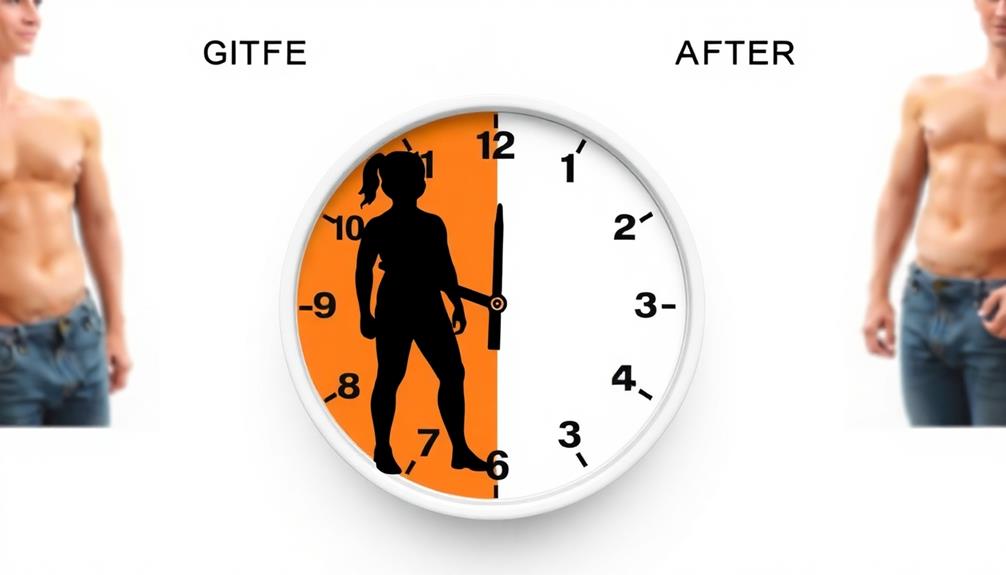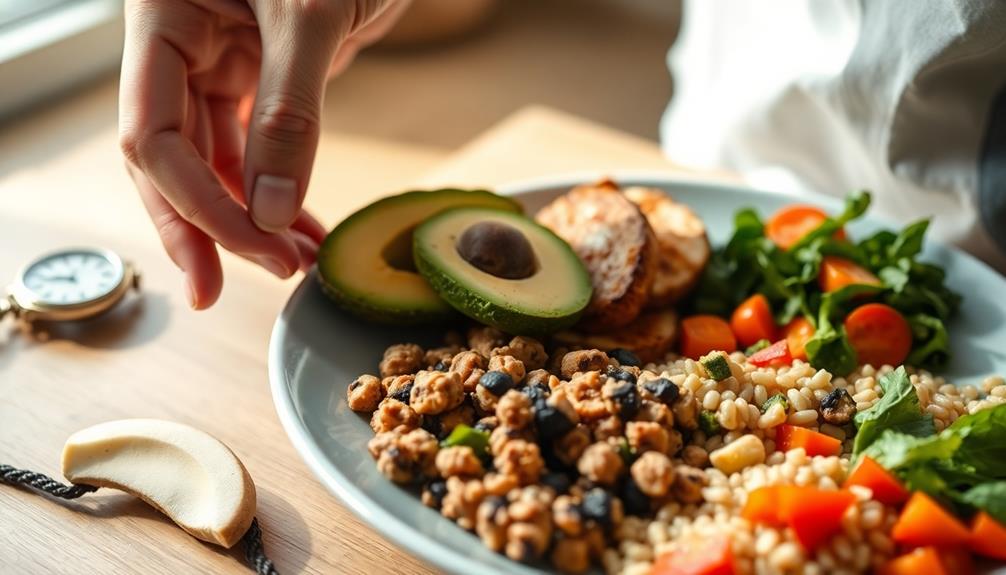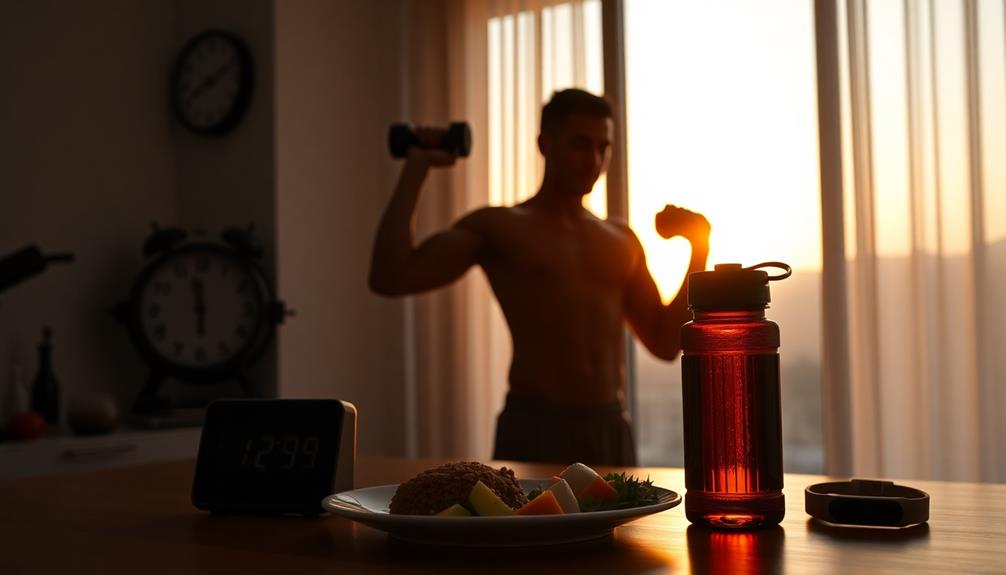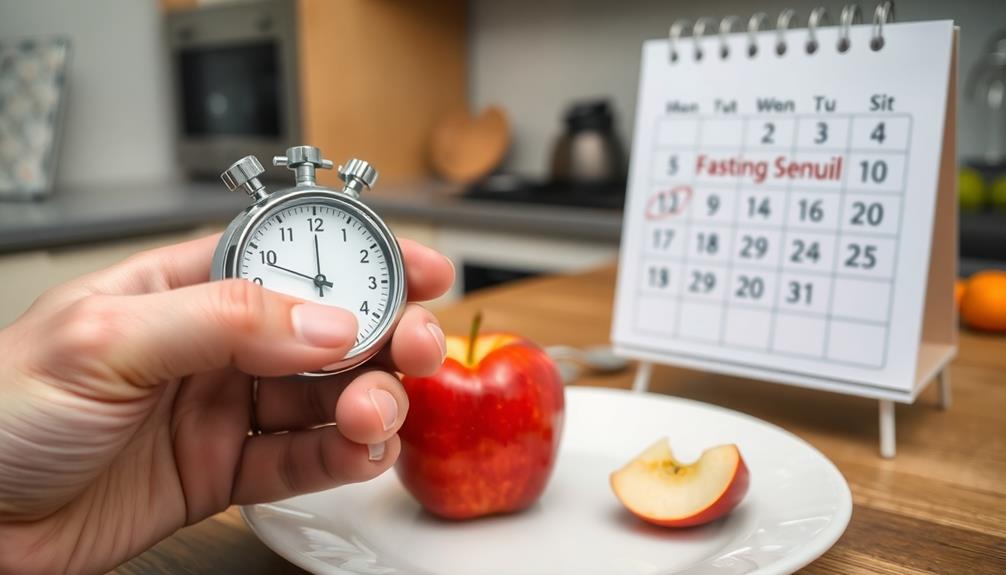To use intermittent fasting for effective cutting, choose a protocol that fits your lifestyle, such as the 16/8 method or 5:2 diet. During feeding windows, focus on nutrient-dense foods, balancing proteins, complex carbs, and healthy fats. Time your workouts strategically, either at the end of your fast or after breaking it, to maximize fat burning and energy. Manage hunger by staying hydrated and eating satisfying meals. Track your progress regularly, measuring weight, body fat percentage, and taking progress photos. Be prepared to adjust your fasting window, calorie intake, or exercise plan as needed. By following these strategies, you'll be well-equipped to achieve your cutting goals. The following sections offer more detailed insights into each aspect of this approach.
Core Insight
- Choose a fasting protocol that fits your lifestyle, like 16/8 or 5:2, and stick to it consistently.
- Focus on nutrient-dense, high-protein foods during eating windows to preserve muscle mass.
- Time workouts at the end of fasting periods or immediately after breaking fast for enhanced fat burning.
- Track progress through weekly weigh-ins, monthly measurements, and body fat percentage checks.
- Adjust calorie intake and fasting windows as needed based on progress to maintain steady fat loss.
Understanding Intermittent Fasting Protocols

Intermittent fasting has several different approaches. They all cycle between periods of fasting and eating. The four most common types are:
- 16/8 Method: Fast for 16 hours, eat within an 8-hour window each day.
- 5:2 Diet: Eat normally five days a week, limit calories to 500-600 two days a week.
- Eat-Stop-Eat: Fast for a full 24 hours once or twice per week.
- Alternate-Day Fasting: Switch between fasting days and normal eating days.
Each type has pros and cons. The 16/8 method is usually the easiest to stick with. The 5:2 diet gives you more flexibility. Eat-Stop-Eat and Alternate-Day Fasting can be harder but might work better. Pick the one that works best for your lifestyle and goals.
When you do intermittent fasting, it's important to eat healthy during your eating windows. Think about taking quality supplements to support your cutting goals. And make sure you get the nutrition you need on days when you do eat.
Nutrition During Feeding Windows

During your feeding windows, focus on eating healthy foods that help you reach your cutting goals. Choose proteins like chicken, fish, and lean beef to maintain muscle. Eat complex carbs such as whole grains, sweet potatoes, and quinoa for long-lasting energy. Include healthy fats from avocados, nuts, and olive oil. Adding mushroom extracts to your diet may improve endurance and recovery while cutting.
Eat a balance of protein, carbs, and fat, with extra emphasis on protein for muscle support. Include plenty of vegetables in your meals for vitamins, minerals, and fiber. Drink a lot of water during your feeding window to stay hydrated.
Avoid overeating after fasting by controlling portion sizes and sticking to your calorie targets. Plan your meals ahead of time to ensure you're getting the nutrition you need within your eating windows.
Workout Timing and Performance

Timing your workouts right can boost the effects of intermittent fasting when cutting. For best results, plan your training near the end of your fast or right after you break it. This lets you burn more fat while still having energy for tough workouts. To help your body recover, think about using fast-acting carb powders after exercising to quickly refill your energy stores.
If you fast in the morning, try working out before your first meal. This can help you burn even more fat. But if you feel weak or dizzy, eat something small before exercising.
If you fast later in the day, try working out just before you break your fast. This can help your body absorb nutrients better and recover faster after your workout. Don't forget to drink plenty of water during your fasts, especially when you exercise.
Managing Hunger and Cravings

Dealing with hunger and cravings is a common challenge when fasting to lose weight. To handle these issues, eat foods packed with nutrients during your eating window. They'll keep you satisfied longer and give you the nutrients you need. Drink water throughout the day, as being thirsty can feel like hunger. When cravings strike, try doing something else, like taking a walk or talking to a friend. Plan your meals ahead of time, so you always have healthy food ready. Keep healthy snacks like low-sugar energy bars around for emergencies. They can give you a quick boost without messing up your fast.
If you get too hungry, think about changing your fasting window or eating a little more. It's okay to feel some hunger when cutting, but it shouldn't be too much. Pay attention to your body and make changes if needed. As you keep practicing, you'll find what works best for you.
Tracking Progress and Adjusting

Tracking your progress is key when doing intermittent fasting and cutting. Weigh yourself once a week and measure your body once a month. Write down your fasting times, what you eat, and your workouts. This will help you see patterns and find ways to improve. Don't just focus on your weight, as it can change for many reasons. Take progress photos and measure your body fat percentage for a better overall picture. While fasting alone can work, some people may get better cutting results by adding keto supplements to support their fasting.
As you track, be ready to make changes. If you're not getting the results you want, try adjusting your fasting window, how many calories you eat, or your exercise plan. Everyone's body is different, so what works for others may not work for you. Be patient and stick with it. Give each change at least two weeks before making more adjustments. By regularly checking your progress and making smart changes, you'll get the best results from intermittent fasting and cutting.
Frequently Asked Questions
Can Intermittent Fasting Cause Muscle Loss During Cutting?
Yes, intermittent fasting can potentially cause muscle loss during cutting if you're not careful. You'll need to maintain adequate protein intake and continue resistance training to preserve muscle mass while in a caloric deficit.
Is It Safe to Practice Intermittent Fasting While Taking Medications?
You should consult your doctor before practicing intermittent fasting while on medications. Some meds require specific timing with food, and fasting might affect their absorption or effectiveness. It's important to prioritize your health and follow medical advice.
How Does Intermittent Fasting Affect Hormone Levels During a Cutting Phase?
During a cutting phase, intermittent fasting can impact your hormone levels. You'll likely experience increased growth hormone and norepinephrine, which aid fat burning. However, you might also see a temporary decrease in testosterone and thyroid hormones.
Can Women Effectively Use Intermittent Fasting for Cutting, Considering Menstrual Cycles?
Yes, you can effectively use intermittent fasting for cutting, even with menstrual cycles. However, you'll need to pay attention to your body's signals and adjust your fasting schedule accordingly. It's best to consult a healthcare professional for personalized advice.
Are There Any Long-Term Health Risks Associated With Intermittent Fasting?
While intermittent fasting is generally safe, you should be aware of potential long-term risks. These may include nutrient deficiencies, hormonal imbalances, and disrupted metabolism. It's essential to consult your doctor before starting any fasting regimen.

